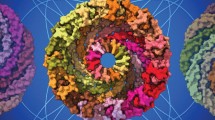Abstract
Using fluorescence immunocytochemistry, transmission electron microscopy and Western blotting, we have shown that caveolae and caveolin are abundant on chondrocytes of different cartilaginous structures of newborn and adult rat knee joints. Caveolin was detected in chondrocytes of the outer layer of articular cartilage, in the fibrocartilage of the menisci, and in fibrocartilage-like cells at tendon and ligament insertions. Electron microscopical studies revealed caveolae-like invaginations along the plasmalemmal membrane of articular chondrocytes and fibrocartilage cells. Immunoblot analysis demonstrated caveolin in detergent-insoluble and soluble complexes isolated from cultured rat chondrocytes.
Similar content being viewed by others
References cited
Anderson RG (1998) The caveolar membrane system. Annu Rev Biochem 67: 199-225.
Anderson RG, Kamen BA, Rothberg KG, Lacey SW (1992) Potocytosis: sequestration and transport of small molecules by caveolae. Science 255: 410-411.
Cameron PL, Rufin JW, Bollag R, Rasmussen H, Cameron RS (1997) Identification of caveolin and caveolin-related proteins in the brain. J Neurosci 17: 9520-9535.
Chang WJ, Ying YS, Rothberg KG, Hooper NM, Turner AJ, Gambliel HA, De Gunzburg J, Mumby SM, Gilman AG, Anderson RG (1994) Purification and characterization of smooth muscle cell caveolae. J Cell Biol 126: 127-138.
Conrad PA, Smart EJ, Ying Y-S, Anderson RGW, Bloom GS (1994) Caveolin cycles between plasma membrane caveolae and the Golgi complex by microtubule-dependent and microtubule-independent steps. J Cell Biol 127: 1185-1197.
Freshney RI (1987) Culture of Animal Cells. A Manual of Basic Techniques. 2nd edn. New York: Alan R. Liss.
Hay ED, Hasty DL (1979) Extrusion of particle-free membrane blisters during glutaraldehyde fixation. In Rash JE, Hudson CS, eds. Freeze Fracture: Methods, Artefacts, and Interpretations. New York: Raven Press, pp. 59-66.
Kasper M, Reimann T, Hempel U, Wenzel K-W, Bierhaus A, Schuh D, Dimmer V, Haroske G, Müller M (1998) Loss of caveolin expression in type I pneumocytes as an indicator of subcellular alterations during lung fibrogenesis. Histochem Cell Biol 109: 41-48.
Kurzchalia TV, Parton RG (1996) And still they are moving... Dynamic properties of caveolae. FEBS Lett 389: 52-54.
Lee SW, Reimer CL, Oh P, Campbell DB, Schnitzer JE (1998) Tumor cell growth inhibition by caveolin re-expression in human breast cancer cells. Oncogene 16: 1391-1397.
Li S, Couet J, Lisanti MP (1996) Src tyrosine kinases, G alpha subunits, and H-Ras share a common membrane-anchored scaffolding protein, caveolin. Caveolin binding negatively regulates the auto-activation of Src tyrosine kinases. J Biol Chem 271: 29182-29190.
Li S, Galbiati F, Volonte D, Sargiacomo M, Engelman JA, Das K, Scherer PE, Lisanti MP (1998) Mutational analysis of caveolininduced vesicle formation. FEBS Lett 434: 127-134.
Lisanti MP, Scherer PE, Vidugiriene J, Tang Z, Hermanowsk-Vosatka, A, Tu YH, Cook RF, Sargiacomo M (1994) Characterization of caveolinrich membrane domains isolated from an endothelial-rich source: implications for human disease. J Cell Biol 126: 111-126.
Lisanti MP, Tang Z, Scherer PE, Kubler E, Koleske AJ, Sargiacomo M (1995) Caveolae, transmembrane signalling and cellular transformation. Mol Membr Biol 12: 121-124.
Liu P, Ying Y, Ko Y, Anderson RGW (1996) Localization of plateletderived growth factor-stimulated phosphorylation cascade to caveolae. J Biol Chem 271: 10299-10303.
Liu P, Ying Y, Anderson RG (1997) Platelet-derived growth factor activates mitogen-activated protein kinase in isolated caveolae. Proc Natl Acad Sci USA 94: 13666-13670.
Okamoto T, Schlegel A, Scherer TE, Lisanti MP (1998) Caveolins, a family of scaffolding proteins for organizing 'preassembled signalling complexes' at the plasma membrane. J Biol Chem 273: 5419-5422.
Parton RG (1996) Caveolae and caveolins. Curr Opin Cell Biol 8: 542-548.
Parton RG, Joggerst B, Simons K (1994) Regulated internalization of caveolae. J Cell Biol 127: 1199-1215.
RizzoV, McIntosh DP, Schnitzer JE (1998) In situ flowactivates endothelial nitric oxide synthase in luminal caveolae of endothelium with rapid caveolin dissociation and calmodulin association. J Biol Chem 273: 34724-34729.
Rothberg KG, Heuser JE, Donzell WC, Ying Y, Glenney JR, Anderson RGW (1992) Caveolin, a protein component of caveolae membrane coats. Cell 68: 673-682.
Schwab W, Bilgiçyldirim A, Funk RHW (1997) Microtopography of the autonomic nerves in the rat knee: a fluorescence microscopic study. Anat Rec 247: 109-118.
Severs NJ (1988) Caveolae: static inpocketings of the plasma membrane, dynamic vesicles or plain artefact? J Cell Sci 90: 341-348.
Shakibei M, De Souza P (1997) Differentiation of mesenchymal limb bud cells to chondrocytes in alginate beads. Cell Biol Internat 21: 75-86.
Shaul PW, Anderson RGW (1998) Role of plasmalemmal caveolae in signal transduction. Am J Physiol 275: L843-851.
Smart EJ, Ying Y, Anderson RGW (1995) Hormonal regulation of caveolae internalization. J Cell Biol 131: 929-938.
Traub O, Berk BC (1998) Laminar shear stress. Mechanisms by which endothelial cells transduce atheroprotective force. Arterioscler Thromb Vasc 18: 677-685.
Yamamoto M, Toya Y, Schwencke C, Lisanti MP, Myers MG, Ishikawa Y (1998) Caveolin is an activator of insulin receptor signalling. J Biol Chem 273: 26962-26968.
Wilsman NJ, Farnum CE, Reed-Aksamit DK (1981) Caveolar system of the articular chondrocyte. J Ultrastruc Res 74: 1-10.
Author information
Authors and Affiliations
Rights and permissions
About this article
Cite this article
Schwab, W., Hempel, U., Funk, R.H. et al. Ultrastructural Identification of Caveolae and Immunocytochemical as Well as Biochemical Detection of Caveolin in Chondrocytes. Histochem J 31, 315–320 (1999). https://doi.org/10.1023/A:1003718002088
Issue Date:
DOI: https://doi.org/10.1023/A:1003718002088




